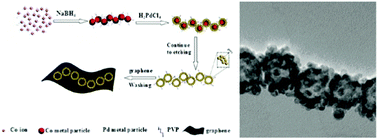Hollow palladium nanospheres with porous shells supported on graphene as enhanced electrocatalysts for formic acid oxidation†
Abstract
The hollow palladium nanospheres with the porous shell comprised of uniform 5 nm Pd nanoparticles (Pd NS-HP) have been synthesized successfully by employing a simple replacement process between PdCl42− ions and Co with the assistance of a structure-directing agent, polyvinyl pyrrolidone (PVP). Then, the obtained Pd NS-HP is supported on graphene nanosheets (GN) to prepare Pd NS-HP/GN composites by a wet-impregnation method. As the catalyst towards formic acid electrooxidation, the Pd NS-HP/GN composite exhibits a larger electrochemically active surface area, better electrocatalytic activity and better stability compared with Pd nanoparticles/graphene (Pd NP/GN) and commercial Pd/C catalysts. The enhancement in electrocatalytic performance of Pd NS-HP/GN is attributed to the abundant connected pore channels in the inner and exterior surfaces of Pd nanospheres, which could provide a large contact surface for adsorption and transmission of reactants, facilitating the oxidation of formic acid molecules on its surface and also improving the utilization of Pd metal. Moreover, the support of graphene could enhance the stability of the catalyst.


 Please wait while we load your content...
Please wait while we load your content...